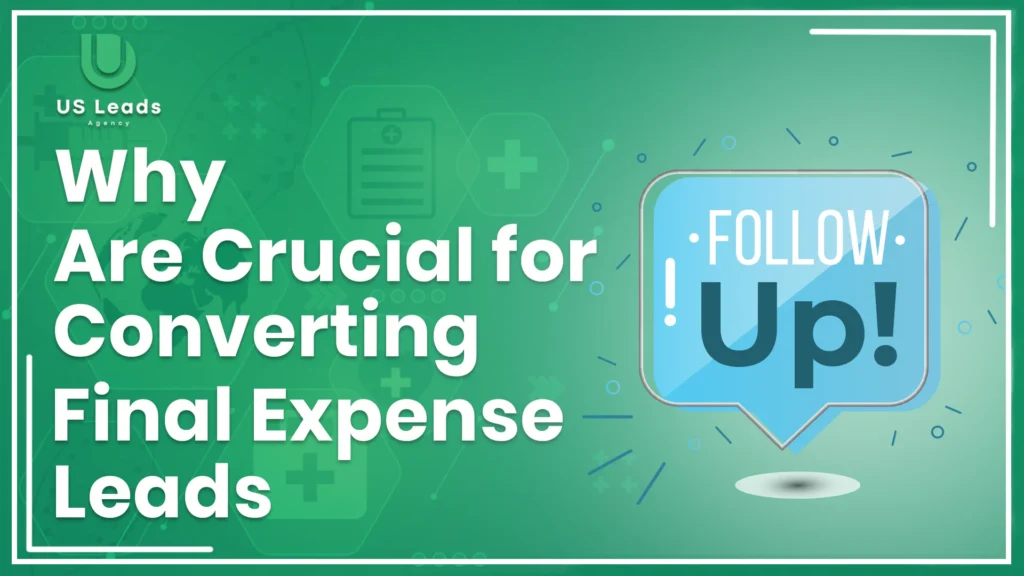
Final expense lead conversion follow-ups, designed to cover end-of-life costs such as funeral expenses and medical bills, has become an essential product for insurance agents. The competition to secure leads in this niche market is fierce, making it crucial for insurance agents to not only generate high-quality leads but also to ensure they convert these leads into paying customers. One of the most effective strategies in converting final expense leads is the art of follow-ups.
6 Key Takeaways:
- Build Trust: Follow-ups allow insurance agents to establish trust with prospects, especially in the final expense market, where decisions may take time.
- Address Objections: Use follow-ups to clarify policy benefits and address any concerns or objections prospects may have.
- Improve Conversion Rates: Consistent follow-ups increase the chances of converting leads into paying customers.
- Strategic Timing: Follow-up intervals should be carefully planned to avoid overwhelming or losing touch with prospects.
- Nurture Leads: Regular follow-ups help keep leads warm and engaged until they are ready to purchase.
- Close the Sale: A well-timed final follow-up can act as the nudge prospects need to commit to a policy.
Follow-ups are more than just a courtesy; they are a critical part of the sales funnel. A well-timed and strategic follow-up can make the difference between a successful sale and a lost lead.
This article explores why final expense lead conversion follow-ups are essential and provides actionable strategies for insurance agents to enhance their follow-up process.
Table of Contents
Why final expense lead conversion follow-ups are Critical
1. Building Trust with Prospects
The final expense lead conversion follow-ups insurance market targets individuals who are typically older and may require more time to make financial decisions. These prospects may not immediately commit to purchasing a policy after the first interaction. Consistent follow-ups provide an opportunity to build a relationship and establish trust, which is crucial for this demographic. By staying in touch and addressing any concerns, agents can ease prospects’ fears, showing that they genuinely care about their needs rather than just closing a sale.
2. Addressing Objections and Clarifying Benefits
Many prospects may hesitate due to unanswered questions or perceived barriers, such as price or understanding of policy benefits. A follow-up offers the chance to address these concerns directly. During final expense lead conversion follow-ups calls or meetings, agents can provide tailored information that clarifies how the policy fits the prospect’s needs. It also allows for personalized communication, which can be more persuasive than a generic sales pitch.
3. Increasing Lead Conversion Rates
Statistics show that most sales happen after the fifth follow-up, yet many agents stop after the first or second contact. By consistently following up, agents increase the likelihood of converting leads into customers. Persistent yet respectful final expense lead conversion follow-ups keep the insurance agent top of mind when the prospect is ready to make a decision, increasing the conversion rate significantly.
4. Timing Matters: Strategic Follow-Up Intervals
The timing and frequency of final expense lead conversion follow-ups play a significant role in their effectiveness. Too frequent, and prospects may feel pressured; too infrequent, and they may forget about the agent altogether. A strategic approach involves initially contacting the lead within 24 to 48 hours of the first interaction and then following up at regular intervals. Each follow-up should have a clear purpose—whether it’s answering a question, offering additional resources, or moving the lead further down the sales funnel.
5. Keeping Leads Warm
Not every prospect will be ready to buy immediately. Some may need time to consult with family members, review their financial situation, or simply think things over. Regular follow-ups keep these leads “warm,” meaning they remain engaged with the agent rather than seeking out competitors. This sustained contact allows agents to nurture leads, staying relevant and top-of-mind until they are ready to make a decision.
6. Closing the Sale: The Final Push
Follow-ups often act as the final nudge prospects need to commit to a policy. After multiple interactions, prospects have likely built trust, had their concerns addressed, and feel confident in their decision. Agents can use the final expense lead conversion follow-up as an opportunity to push the sale forward by offering incentives, creating a sense of urgency, or simply reminding the prospect of the policy’s benefits. This strategic final push can be the key to closing the deal.
Final Expense Lead Conversion Follow-Ups Practices:
- Personalization: Each follow-up should be personalized based on the previous interaction with the prospect. Generic follow-ups are less effective and may feel impersonal.
- Use Multiple Channels: Follow-ups should not be limited to phone calls. Emails, text messages, and even social media can be effective ways to maintain contact with leads.
- Track Progress: Use a CRM system to track follow-ups, ensuring no lead is neglected, and each follow-up is timed correctly.
- Provide Value: Every follow-up should offer something of value, whether it’s additional information, a resource, or addressing a concern.
- Stay Consistent but Respectful: Follow up consistently but avoid overwhelming the prospect with too frequent contact.
- Know When to Stop: While persistence is key, knowing when a lead is not worth pursuing further can save time and resources.
Conclusion
Follow-ups are an essential part of the final expense lead conversion process. They help build trust, clarify benefits, keep leads warm, and ultimately drive conversions. For insurance agents looking to improve their sales, mastering the art of follow-ups is a vital skill that can lead to a substantial increase in closed deals. By following a strategic, respectful, and personalized approach to follow-ups, agents can ensure they remain top of mind when the prospect is ready to make a purchase.
